the Creative Commons Attribution 4.0 License.
the Creative Commons Attribution 4.0 License.
Reconstruction of the track and a simulation of the storm surge associated with the calamitous typhoon affecting the Pearl River Estuary in September 1874
Hing Yim Mok
Wing Hong Lui
Dick Shum Lau
Wang Chun Woo
A typhoon struck the Pearl River Estuary in September 1874 (“Typhoon 1874”), causing extensive damage and claiming thousands of lives in the region during its passage. Like many other historical typhoons, the deadliest impact of the typhoon was its associated storm surge. In this paper, a possible track of the typhoon was reconstructed through an analysis of the historical qualitative and quantitative weather observations in the Philippines, the northern part of the South China Sea, Hong Kong, Macao, and Guangdong recorded in various historical documents. The magnitudes of the associated storm surges and storm tides in Hong Kong and Macao were also quantitatively estimated using storm surge model and analogue astronomical tides based on the reconstructed track. The results indicated that the typhoon could have crossed the Luzon Strait from the western North Pacific and moved across the northeastern part of the South China Sea to strike the Pearl River Estuary more or less as a super typhoon in the early morning on 23 September 1874. The typhoon passed about 60 km south–southwest of Hong Kong and made landfall in Macao, bringing maximum storm tides of around 4.9 m above the Hong Kong Chart Datum (http://www.geodetic.gov.hk/smo/gsi/Data/pdf/explanatorynotes.pdf, last access: 3 January 2020) at the Victoria Harbour in Hong Kong and around 5.4 m above the Macao Chart Datum (https://mosref.dscc.gov.mo/Help/ref/Macaucoord_2009_web_EN_v201702.pdf, last access: 3 January 2020) at Porto Interior (inner harbour) in Macao. Both the maximum storm tide (4.88 m above the Hong Kong Chart Datum) and maximum storm surge (2.83 m) brought by Typhoon 1874 at the Victoria Harbour estimated in this study are higher than all the existing records since the establishment of the Hong Kong Observatory in 1883, including the recent records set by super typhoon Mangkhut on 16 September 2018.
- Article
(11164 KB) - Full-text XML
-
Supplement
(555 KB) - BibTeX
- EndNote
Hong Kong, located on the coast of southern China, is vulnerable to sea flooding due to storm surges associated with approaching tropical cyclones from the western North Pacific or the South China Sea. Since the establishment of the Hong Kong Observatory in 1883 when records of tropical cyclones affecting Hong Kong began, storm surges induced by typhoons in 1906, 1936, and 1937, as well as super typhoon1 Wanda in 1962, brought severe casualties and damage to Hong Kong (Peterson, 1975; Ho, 2003). Storm surges induced by super typhoon Hato in 2017 (https://www.hko.gov.hk/en/informtc/hato17/hato.htm, last access: 3 January 2020; Lau and Chan, 2017) and super typhoon Mangkhut in 2018 (https://www.hko.gov.hk/en/blog/00000216.htm, last access: 3 January 2020), even though with no significant casualties, still brought severe flooding and damage to Hong Kong during their passages. The storm surges or the storm tides observed in the Victoria Harbour associated with these typhoons ranked in the top five on record since the establishment of the Hong Kong Observatory in 1883. The storm surge and sea level records, as well as the tracks of these typhoons, are shown in Table 1 and Fig. 1, respectively.
Table 1Records of the top five storm surges and storm tides recorded in the Victoria Harbour in Hong Kong since the establishment of the Hong Kong Observatory in 1883 in chronological order. (The ranking of the top five is shown in parentheses.)
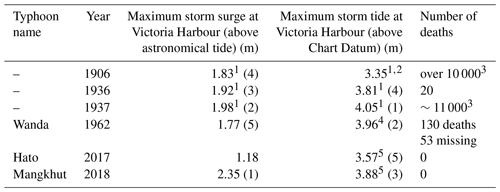
1 Based on tide pole observations, field surveys, or reports from local residents. The operation of the tide gauge network started in 1952. 2 Information on the reference level for the storm tide reading was not available as the Chart Datum was not yet established in 1906. 3 According to press reports. 4 Recorded at the tide gauge station at North Point in the Victoria Harbour 5 Recorded at the tide gauge station at Quarry Bay (about 500 m east of North Point) in the Victoria Harbour.
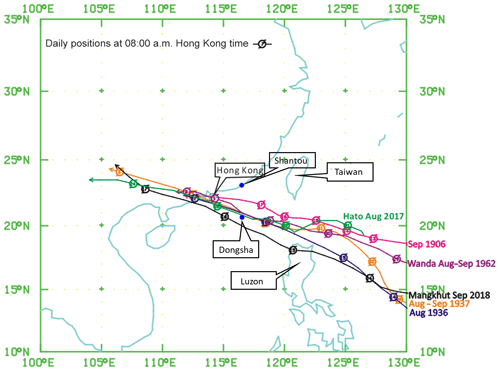
Figure 1Daily positions at 08:00 Hong Kong time of the typhoons affecting Hong Kong on 13–18 September 1906 (Typhoon Sep 1906), 14–17 August 1936 (Typhoon Aug 1936), 29 August to 3 September 1937 (Typhoon Aug–Sep 1937), super typhoon Wanda from 29 August to 2 September 1962 (Wanda Aug–Sep 1962), super typhoon Hato on 21–24 August 2017 (Hato Aug 2017), and super typhoon Mangkhut on 14–17 September 2018 (Mangkhut Sep 2018).
Figure 1 shows that typhoons bringing a significant storm surge impact to Hong Kong have similar tracks – forming and intensifying into at least typhoon strength over the western North Pacific, moving across the Luzon Strait without making landfall over the Philippines and Taiwan (except Mangkhut, which skirted the northern part of Luzon), approaching the coast of Guangdong, and making landfall over or passing to the south of Hong Kong. Typhoons moving across the Luzon Strait without making landfall over the Philippines and Taiwan can maintain their intensity, and making landfall over or passing to the south of Hong Kong will generate onshore winds that bring severe storm surges to the territory.
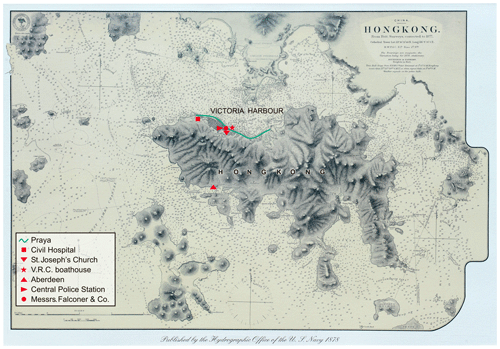
Figure 2Historical Hong Kong map published by the Hydrographic Office of the UK Navy in 1878 (owned by Chi Ming Shun) showing the Praya along the northern coast of Hong Kong Island and the locations of the Civil Hospital, St. Joseph's Church, the V.R.C. boathouse, Aberdeen, the Central Police Station, and Messrs. Falconer & Co. on Hong Kong Island.
However, for a better understanding of the storm surge risk in Hong Kong from a historical perspective, one should not ignore the calamitous typhoon which struck the Pearl River Estuary during 22–23 September 1874 (hereafter “Typhoon 1874”), bringing extensive damage and claiming several thousand lives in Hong Kong, and this might have prompted the establishment of the Hong Kong Observatory (the official weather authority in Hong Kong) later in 1883. Hong Kong Typhoons (Heywood, 1950) recorded that “the typhoon demolished the Civil Hospital and St. Joseph's Church (the locations are marked in Fig. 2). A warship dragged her moorings and was thrown into V.R.C. boathouse” (the location is marked in Fig. 2). As described in the report by the Captain Superintendent of Police (Hong Kong Government, 1874), “the Police had recovered the bodies of 621 people, but this number probably represented only one-third of the actual figure. Furthermore, over 200 houses were destroyed or rendered uninhabitable. Two steamers sank in the harbour and another steamer was on shore near Aberdeen (the location is marked in Fig. 2), and eight ships were supposed to have been lost. It was impossible to estimate the destruction of junks and small boats. Telegraph posts were blown down in different parts of the Hong Kong Island, interrupting communications. The roads were almost impassable from the obstruction caused by the fallen trees.” The China Mail of 23 September 1874 (China Mail, 1874) also reported that “a typhoon, though of very short duration, has probably proved the most destructive witnessed since 1862 – if not exceeding it in that respect – swept over the island between the hours of 06:00 p.m. and 06:00 a.m.”.
Like many other historical typhoons which caused significant casualties, the deadliest impact of Typhoon 1874 was its associated storm surge. The Harbour Master reported in the Hong Kong Government Gazette of 17 October 1874 (Hong Kong Government, 1874) that “the strength of the wind brought an immense volume of water into the harbour, not a tidal wave, but a rapid rise which continued for about an hour, flooding the Praya and ground floors of houses to a height of 4 and 5 feet for some distance inshore. Although, according to ordinary calculation it should have been low water at two o'clock; by three, the water had risen to from five to six feet above its high water level, or a rise of about ten feet had taken place” (the Prata is coloured in green in Fig. 2).
Typhoon 1874 also caused severe damage to Macao on the western side of the Pearl River Estuary. According to the publication O Maior Tufao De Macau – 22 e 23 de Setembro de 1874 by Father Manuel Teixeira (Teixeira, 1974), the passage of Typhoon 1874 was also accompanied by a storm surge which caused severe flooding of up to 2.1 m (7 ft) above the high tide level. The Times of Typhoon published by the Arquivo Historico De Macao (2014) summarized that “the strong winds, fierce waves and fires destructed countless buildings and infrastructures, around 2000 fishing vessels and cargo ships were sunk. The storm claimed around 5000 lives, including approximately 3600 in the Macao Peninsula, 1000 in Taipa and 400 in Coloane. The cost of the damage was estimated to be up to 2 million silver coins” (the locations are shown in Fig. 3). Out of an estimated population of around 60 000 people in Macao (Ou, 2014), the fatalities accounted for approximately 8 % of the population.
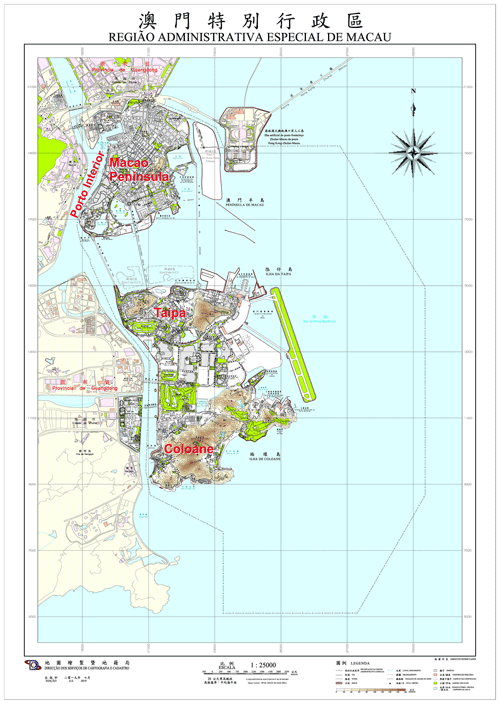
Figure 3Topographic map of Macao in 2019 (© Macao Special Administrative Region Government – Cartography and Cadastre Bureau) showing the locations of Porto Interior, Macao Peninsula, Taipa, and Coloane.
While Typhoon 1874 was one of the most damaging typhoons with a significant storm surge in Hong Kong, no official records of any kind were available. A reconstruction of the typhoon track and a quantitative estimation of its associated storm surge and storm tide during its passage based on the reconstructed track are therefore highly desirable for comparison with the other historical typhoons which affected Hong Kong, in particular those which generated the significant storm surges and/or tides listed in Table 1, and more importantly for assessing the storm surge risk in Hong Kong.
The objective of this study is to reconstruct the lifespan of Typhoon 1874 and to quantitatively estimate the storm surges and storm tides which might have been experienced in Hong Kong during its passage. The storm surges and storm tides in Macao are also quantitatively estimated for comparison in this study.
A search and analysis of publicly available historical documents related to Typhoon 1874 was conducted to acquire the relevant information for reconstructing the track of the typhoon using the Jelesnianski tropical cyclone model (Jelesnianski, 1965). With the reconstructed track, the storm surges at Hong Kong and Macao during its passage were estimated by the storm surge model SLOSH (Sea, Lake, and Overland Surges from Hurricanes) developed by the US National Oceanic and Atmospheric Administration (NOAA). The astronomical tides were estimated by analogue with dates of a similar Sun–Earth–Moon configuration for the estimation of the storm tides (sum of storm surges and astronomical tides).
After a search and study of historical documents, the following information available from the Philippines, Hong Kong, and Macao provided valuable weather and tidal observations for reconstructing the lifespan and revealing the power of Typhoon 1874:
- a.
the Selga Chronology Part I, available at http://www.ucm.es/info/tropical/selga-i.html (last access: 3 January 2020; García-Herrera et al., 2020), containing wind and pressure records in the vicinity of the Luzon Strait during the passage of Typhoon 1874;
- b.
the Harbour Master report in the Hong Kong Government Gazette on 17 October 1874 (Hong Kong Government, 1874) containing the qualitative observations of three ships (namely the British ship Onward, American ship Highlander, German ship Amanda) on Typhoon 1874 near the Pratas Shoal (now called Dongsha, as marked in Fig. 1) over the northeastern part of the South China Sea, a description of the sequence of weather changes in the Victoria Harbour, and pressure readings at the Central Police Station (the location is marked in Fig. 2) in Hong Kong during the passage of Typhoon 1874;
- c.
the China Mail of 23 September 1874 (China Mail, 1874) and Hong Kong Daily Press of 24 September 1874 (Hong Kong Daily Press, 1874) containing pressure readings reduced to mean sea level in the Victoria Harbour from the Harbour Master and pressure readings recorded by two barometers of a local company, Messrs. Falconer & Co., Hong Kong (the location is marked in Fig. 2), during the passage of Typhoon 1874;
- d.
the Hong Kong Daily Press of 25 September 1874 (Hong Kong Daily Press, 1874) describing the impact of Typhoon 1874 on Swatow (now called Shantou, as marked in Fig. 1) at the eastern coast of the Guangdong Province of China;
- e.
the logbook of the vessel HMS Princess Charlotte moored at the Victoria Harbour, which is now kept at the National Archives in London, UK, containing observations on pressure and winds for 22 and 23 September 1874;
- f.
the bulletin of the Province of Macao and Timor published on 3 October 1874 (Macao Government, 1874) containing ship reports for 22 to 23 September 1874 by the gunboat Tejo moored at Porto Interior (the location is shown in Fig. 3) in Macao;
- g.
the bulletin of the Province of Macao and Timor published on 24 October 1874 (Macao Government, 1874) containing weather observations from 11:00 on 22 September to 10:00 on 23 September 1874 by the Macao Port Authority; and
- h.
a book on historical disastrous tidal events in China (Lu, 1984) describing the track of Typhoon 1874 in the Pearl River Estuary and inland western Guangdong as well as its damage to the region.
The construction of a possible track of Typhoon 1874 was divided into three parts in this study, namely (a) over the Luzon Strait, (b) over the South China Sea, and (c) over the Pearl River Estuary.
3.1 Luzon Strait
A description of the passage of Typhoon 1874 in the vicinity of the Luzon Strait was found in the Selga Chronology Part I: 1348–1900 (García-Herrera et al., 2020). Supplement Sect. S1 is an extract of the part on Typhoon 1874 with a description of the meteorological conditions at two observation points, Vigan (a city near the western coast of Luzon) and the Batan Islands in the Luzon Strait, during the passage of the typhoon. The locations of Vigan and the Batan Islands are marked in Fig. 6.
Table 2Chronological summary of weather observations at Vigan and the Batan Islands (extracted from Sect. S1) during the passage of Typhoon 1874.
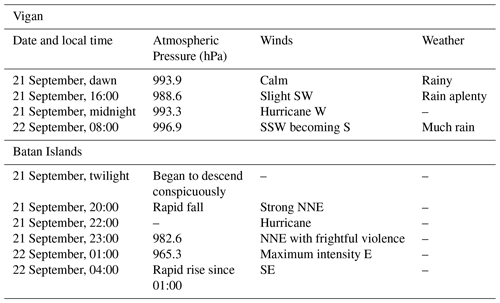
Note: the following conversion factor has been adopted:
1 mm mercury = 1.33322387 hPa;
Marvin et al. (1918).
Table 2 shows the chronological summary of the meteorological observations at the two locations based on the information in Sect. S1. It can be seen that the Batan Islands and Vigan were affected by hurricane force winds from the east and west, respectively, at around midnight on 21 September, suggesting that the centre of Typhoon 1874 was passing through the area between Vigan and the Batan Islands at about that time. As the pressure recorded at the Batan Islands at 01:00 on 22 September (724 mm Hg or 965.3 hPa) was much lower than that recorded at Vigan at midnight on 21 September (745 mm Hg or 993.3 hPa), the centre of Typhoon 1874 was likely closer to the Batan Islands than Vigan and located over the sea area off the coast of northern Luzon during its passage over the Luzon Strait.
Furthermore, the pressure of 724 mm Hg (965.3 hPa) observed at the Batan Islands at 01:00 on 22 September suggested that Typhoon 1874 had an intensity of at least a typhoon, with the maximum sustained 10 min mean wind speed reaching 130 km h−1 or higher near its centre using the minimum pressure and maximum wind relationship for tropical cyclones in this region (Atkinson and Holliday, 1977). Assuming that the centre of Typhoon 1874 was closer to the Batan Islands, the observed hurricane winds at Vigan suggested that the radius of the hurricane force winds of Typhoon 1874 was over 200 km when it passed through the Luzon Strait.
3.2 South China Sea
The description of Typhoon 1874 over the northeastern part of the South China Sea was found in the Harbour Master report in the Hong Kong Government Gazette published on 17 October 1874 (Hong Kong Government, 1874) which stated that the typhoon passed rather close to the Pratas Shoal (now called Dongsha, as marked in Fig. 1) according to the reports from three ships (the British ship Onward, American ship Highlander, and German barque Amanda) travelling close to the island between 16:00 and 18:00 on 22 September. However, detailed meteorological observations from these three ships could not be found for a more in-depth interpretation, such as whether the typhoon passed to the south or north of Dongsha as it approached the southern China coast.
On the other hand, it was reported in the Hong Kong Daily Press of 25 September 1874 (Hong Kong Daily Press, 1874) that “there has also been a most severe typhoon at Swatow and the sea ran so high as to flood the Custom House, which is three hundred yards inland, to such an extent as to damage the whole of the papers in the office” (Swatow is now called Shantou), indicating that Typhoon 1874 had also brought a severe storm surge to Shantou before reaching the Pearl River Estuary. Considering the distance of about 300 km between Dongsha and Shantou, Typhoon 1874 likely passed to the north rather than to the south of Dongsha.
3.3 Pearl River Estuary
A summary of the pressure observations in Hong Kong and Macao during the passage of Typhoon 1874 extracted from the available historical documents is shown in Table S1 in the Supplement. Figure 4 plots the time series of those pressure observations from 08:00 on 22 September to 11:00 on 23 September 1874. It can be seen that the pressure at Hong Kong reached the minimum of around 975 hPa at 02:00 on 23 September, while the pressure at Macao continued to fall to a minimum of around 946 hPa at 04:00 on 23 September. Furthermore, the pressure readings and pressure falling rates at Hong Kong and Macao were rather close to each other from the evening of 22 September to 02:00 on 23 September. This phenomenon revealed that Typhoon 1874 was at more or less the same distance from Hong Kong and Macao when it approached the Pearl River Estuary during this period.
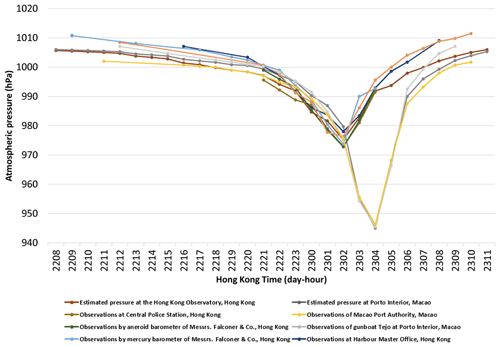
Figure 4Series plots of pressure observations recorded at the Central Police Station, the aneroid barometer of Messrs. Falconer & Co., Hong Kong, the mercury barometer of Messrs. Falconer & Co., Hong Kong, the vessel HMS Princess Charlotte, the Harbour Master's Office in Hong Kong, and the Macao Port Authority and the gunboat Tejo in Macao from 08:00 on 22 September to 11:00 on 23 September 1874 (as listed in Table S1). Also shown are the series plots of atmospheric pressures at Hong Kong (Hong Kong Observatory) and Macao (Porto Interior) during the same period estimated by the Jelesnianski tropical cyclone model based on the hourly positions, hourly minimum mean sea level pressures near the centre, and the radii of the maximum wind of the reconstructed possible track as listed in Table 3.
A summary of the wind observations in Hong Kong and Macao during the passage of Typhoon 1874 extracted from the available historical documents is shown in Table S2. In Hong Kong, the north to northwesterly winds started to strengthen in the evening on 22 September. Winds continued to strengthen, gradually veered to the east–northeast, and reached hurricane force by 02:00 on 23 September. Hurricane force winds were maintained for the next 2 h, while the winds gradually veered to the east–southeast. The winds gradually subsided and veered to the southeast or south–southeast in the early morning on 23 September.
According to the result of a study on the relation between tropical cyclone position and wind direction for wind strength of strong force or above at Waglan Island (an offshore island over the southeastern part of Hong Kong) from 1968 to 2001 (Fig. 5; Hong Kong Observatory), the sequence of wind direction change at Hong Kong during the passage of Typhoon 1874 suggested that it most probably approached Hong Kong from more or less the east and passed to the south of Hong Kong in the small hours on 23 September. This also provided further support for Typhoon 1874 passing to the north of Dongsha during its passage in the northeastern part of the South China Sea.
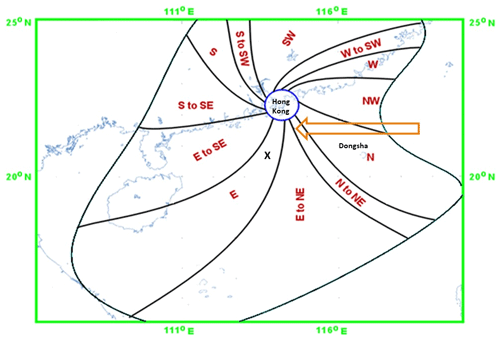
Figure 5The 12-segment reference diagram showing the correlation between the wind direction for wind strength of strong force or above at Waglan Island and the tropical cyclone position used by the Hong Kong Observatory (for example, the winds at Waglan Island will be easterly when the tropical cyclone is located at position “X”). The arrow framed in brown shows the typical track of a tropical cyclone that could cause a sequential change in wind direction in Hong Kong similar to that of the passage of Typhoon 1874.
In Macao, the winds changed in more or less the same way as those in Hong Kong in the evening on 22 September. Hurricane force winds affected Macao from 03:00 to 05:00 on 23 September and there was a rapid change in wind direction of 90∘ from the northeast to southeast at 04:00. The pressure and wind observations in Tables S1 and S2, respectively, revealed that Typhoon 1874 possibly made landfall at Macao or passed rather close to the south of the gunboat Tejo moored at Porto Interior at 04:00 on 23 September with a minimum mean sea level pressure of around 945 hPa near its centre. This minimum mean sea level pressure suggested that the maximum sustained 10 min mean winds near the centre of Typhoon 1874 could have exceeded 180 km h−1 according to Atkinson and Holliday (1977), indicating that the intensity of Typhoon 1874 might have reached the strength of a super typhoon (i.e. maximum sustained 10 min mean wind speed of 185 km h−1 or more) when it made landfall at Macao. Considering that the centre of Typhoon 1874 was at or rather close to Porto Interior in Macao at 04:00 on 23 September, the marginal hurricane force winds observed at Hong Kong as recorded by the vessel HMS Princess Charlotte at 04:00 on 23 September (Table S2) revealed that the hurricane radius of the typhoon was around 70 km (which is the distance between the two observation points in Hong Kong and Macao) at that time.
According to a book on historical disastrous tidal events in China (Lu, 1984), besides Hong Kong and Macao, Typhoon 1874 also caused severe damage and flooding to various cities in western Guangdong in the vicinity of the Pearl River Estuary, including Zhongshan and Panyu, and moved the northwest to reach Zhaoqing, a city about 200 km west–northwest of Hong Kong. This indicated that Typhoon 1874 moved northwest into inland western Guangdong after passing Macao.
Based on the analysis above, Typhoon 1874 possibly passed through the Luzon Strait at around midnight on 21 September, with a maximum sustained 10 min mean wind speed of around 130 km h−1 or higher near its centre and a hurricane radius of over 200 km, and moved across the northeastern part of the South China Sea towards the Pearl River Estuary during the day on 22 September. It more likely passed to the north of Dongsha in the afternoon on 22 September, skirted south of Hong Kong at around 02:00 on 23 September, and made landfall at Macao about 2 h later as more or less a super typhoon (i.e. maximum sustained 10 min mean wind speed of 185 km h−1 or more) with a hurricane radius of around 70 km. It then moved northwest into inland western Guangdong.
Using the pressure observations in Hong Kong and Macao (Table S1 and Fig. 4), as well as the Jelesnianski tropical cyclone model (Jelesnianski, 1965) shown in the equation below, given that Typhoon 1874 made landfall at Macao at 04:00 on 23 September with a minimum mean sea level pressure of 945 hPa near its centre, a possible track of Typhoon 1874 over the northeastern part of the South China Sea, particularly its passage along the coastal waters of eastern Guangdong and the Pearl River Estuary, can be reconstructed.
The Jelesnianski tropical cyclone model is described as
where Pa(r) is the mean sea level pressure at a distance r from the centre of the tropical cyclone, P0 is mean sea level pressure near the centre, Pn is the monthly climatological normal mean sea level pressure for the region, which is taken as 1009 hPa for September in this study, and R is the radius of maximum winds, which is defined as the distance from the centre of a tropical cyclone to the location of the cyclone's maximum winds.
Table 3 shows the hourly positions, hourly minimum mean sea level pressures near the centre, and the radii of maximum winds of the reconstructed possible track of Typhoon 1874 from 08:00 on 22 September to 11:00 on 23 September 1874. The atmospheric pressures at Hong Kong and Macao during the period estimated by the Jelesnianski tropical cyclone model based on the reconstructed possible track, which are also shown in Fig. 4, matched rather well with the observations at both Hong Kong and Macao.
Table 3Hourly positions, hourly minimum mean sea level pressures near the centre, and the radii of maximum winds of the reconstructed possible track of Typhoon 1874 from 08:00 on 22 September to 11:00 on 23 September 1874.
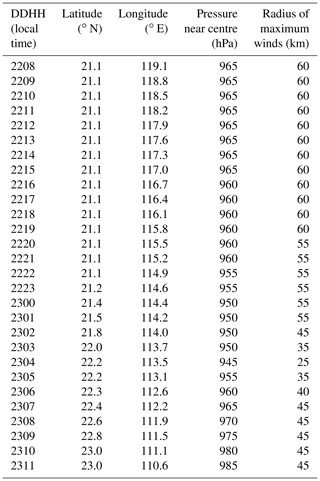
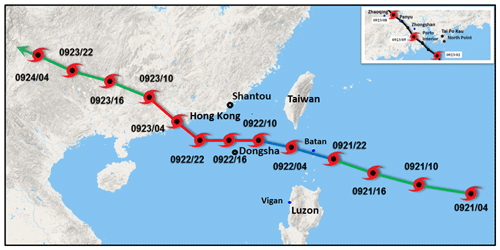
Figure 6Geographical map (© OpenStreetMap contributors 2019; distributed under a Creative Commons BY-SA License) showing the possible track of Typhoon 1874 passing through the Luzon Strait between Taiwan and Luzon and moving across the northern part of the South China Sea reconstructed in this study. The locations of Shantou, Dongsha, Vigan, and Batan are also shown. The small figure at the upper right corner shows the part of the possible track of Typhoon 1874 before and after making landfall at the Pearl River Estuary as well as the locations of the tide gauges at North Point and Tai Po Kau in Hong Kong and Porto Interior in Macao, along with the locations of Zhongshan, Panyu, and Zhaoqing in western Guangdong.
Figure 6 plots the possible track of Typhoon 1874 from the Luzon Strait to inland western Guangdong reconstructed in this study. In Fig. 6, the part of the track in red was based on Table 3, the part in blue (in the morning on 22 September) was estimated by interpolation based on the qualitative analysis discussed in the preceding section, and the parts in green were arbitrarily extended to meet the requirement for the input of 13 6-hourly positions for running the storm surge model for the estimation of storm surges in Hong Kong and Macao. According to this reconstructed track, Typhoon 1874 might have moved at a high speed of about 38 km h−1 on average from the Luzon Strait to the Pearl River Estuary. It picked up a northwesterly track after 22:00 on 22 September when it was about 190 km southeast of Hong Kong to move towards the coast along a track with more or less the same distance from Hong Kong and Macao until 02:00 on 23 September when it was about 60 km south–southwest of Hong Kong, the closest approach to Hong Kong. The typhoon then took a slightly more westerly track to depart Hong Kong and moved towards Macao, resulting in a rapid rise in pressure at Hong Kong but a continuing fall in pressure at Macao. The reconstructed track also reveals the intensification and decrease in the storm size (the hurricane radius decreased from 200 km or larger near the Luzon Strait to around 70 km when making landfall at Macao) of the typhoon during its passage across the northeastern part of the South China Sea.
With the possible track reconstructed in this study, the storm surges that affected Hong Kong and Macao by Typhoon 1874 can be estimated using the storm surge model SLOSH (Sea, Lake, and Overland Surges from Hurricanes) developed by the US National Oceanic and Atmospheric Administration (NOAA) (https://www.nhc.noaa.gov/surge/slosh.php, last access: 3 January 2020) and being used operationally by the Hong Kong Observatory to support storm surge prediction and warning services in Hong Kong. SLOSH requires the input of 13 6-hourly positions, minimum mean sea level pressures near the centre, and the storm sizes in terms of the radius of maximum winds along the tropical cyclone track. It also uses the Jelesnianski tropical cyclone model to generate the wind and pressure fields for determining the storm surges at the point of interest (Jelesnianski et al., 1992). It was verified to have an accuracy of about 0.3 m in root mean square error (Lee and Wong, 2007).
The 6-hourly positions, minimum mean sea level pressures near the centre, and the radii of maximum winds of the reconstructed track of Typhoon 1874 in Fig. 6 used for running SLOSH are shown in Table 4. It can be seen that Table 4 has included the position at 22:00 on 22 September when Typhoon 1874 started to pick up a northwesterly track and the position at 04:00 on 23 September when the typhoon made landfall at Macao. While locating maps of Hong Kong and Macao in the 1880s to obtain coastline information might not be difficult, bathymetry data with a spatial resolution of about 1 km in Hong Kong and Macao waters and about 7 km in the open sea to the south of the Pearl River Estuary (the grid used for running SLOSH; Jelesnianski et al., 1992) in the 1880s are not likely to be available for running SLOSH. Instead, the earliest available digitized topographic and bathymetry information in the early 1990s was used for the estimation in this study. The maximum storm surges as estimated by SLOSH were 2.83 m (at 04:10 on 23 September) at North Point in the Victoria Harbour and 2.83 m (at 04:00 on 23 September) at Tai Po Kau in the northeastern part of Hong Kong where the tide gauges operated by the Hong Kong Observatory since the 1950s and 1960s, respectively, are located. In Macao, the maximum storm surge as estimated by SLOSH was 2.80 m (at 04:00 on 23 September) at Porto Interior where the tide gauge operated in Macao is located. Table 5 summarizes the estimated maximum storm surges at these three tide gauges. The locations of these three tide gauges are also marked in Fig. 6.
Table 4The 13 points of the 6-hourly positions, minimum mean sea level pressures near the centre, and the radii of maximum winds of the reconstructed possible track of Typhoon 1874 used for running SLOSH.
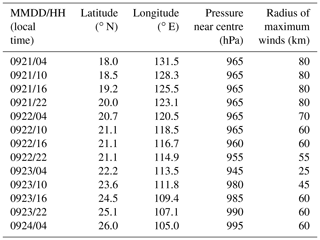
Table 5The estimated maximum storm surges and maximum storm tides at North Point and Tai Po Kau in Hong Kong and Porto Interior in Macao during the passage of Typhoon 1874.

1 Above Hong Kong Chart Datum. 2 Above Macao Chart Datum.
In order to estimate the extreme storm tides (storm surge on top of astronomical tide) in Hong Kong and Macao during the passage of Typhoon 1874, the astronomical tide, which is caused by gravitational forcing mostly from the Sun–Earth–Moon system, is required. For operational estimation of the astronomical tide, the Hong Kong Observatory employs the harmonic method based on decade-long time series of recorded tide levels (Ip and Wai, 1990). This method is, however, limited in its ability to hindcast the astronomical tide so long ago, as the parameters of the constituents need to be inferred from the actual tide level recorded, which was not available for that period.
Instead of adopting the harmonic method directly, the astronomical tide during the passage of Typhoon 1874 was estimated by analogue with dates of a similar Sun–Earth–Moon configuration in this study. Astronomical configurations could be found by referencing the Multiyear Interactive Computer Almanac (MICA) created by the U.S. Naval Observatory (USNO), which utilizes the Jet Propulsion Laboratory (JPL) DE405 ephemerides for position calculations of the Sun, Moon, and major planets. The geometric geocentric positions (equator of J2000.0) of the Sun and the Moon during 22–23 September 1874 were computed with MICA and, after searching through dates since the 1950s (the earliest that tide level observations were available), it was found that 22–23 September 1950, 22–23 September 1969, 22–23 September 1988, and 22–23 September 2007 had higher relevance to 22–23 September 1874, which is not surprising as 1950, 1969, 1988, and 2007 were exactly four Metonic cycles, each of 19 years, after 1874.
Using the earliest available 19-year tide level observations at North Point (1954 to 1972), Tai Po Kau (1969 to 1987), and Porto Interior (1998 to 2016), the astronomical tide during 22–23 September 1874 at the three tide gauge stations could then be taken as the astronomical tide during 22–23 September 1950, 22–23 September 1969, and 22–23 September 2007, respectively.
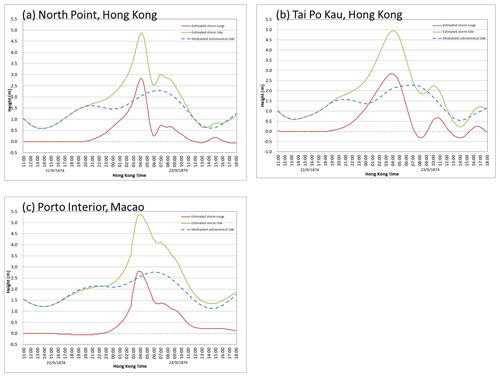
Figure 7Time series of the hindcasted astronomical tide and estimated storm tide above the Hong Kong Chart Datum and the estimated storm surge at (a) North Point and (b) Tai Po Kau in Hong Kong from 11:00 on 22 September to 18:00 on 23 September 1874. Time series of the hindcasted astronomical tide and estimated storm tide above the Macao Chart Datum and the estimated storm surge at (c) Porto Interior in Macao from 11:00 on 22 September to 18:00 on 23 September 1874. The estimated storm tide is the sum of the estimated storm surge and the astronomical tide.
Combining the estimated storm surges and hindcasted astronomical tides, the peak storm tides, which are also shown in Table 5, were estimated to be 4.88 m above the Hong Kong Chart Datum (at 04:10 on 23 September) at North Point, 4.95 m above the Hong Kong Chart Datum (at 04:00 on 23 September) at Tai Po Kau, and 5.37 m above the Macao Chart Datum (at 04:00 on 23 September) at Porto Interior. Figure 7 plots the time series of the hindcasted astronomical tides, estimated storm surges, and storm tides at North Point (Hong Kong), Tai Po Kau (Hong Kong), and Porto Interior (Macao) from 11:00 on 22 September to 18:00 on 23 September 1874.
It can be seen that the hindcasted astronomical tide at North Point showed a low tide from midnight to around 02:00 on 23 September, which was consistent with what the Harbour Master mentioned in his report in the Hong Kong Government Gazette of 17 October 1874 (Hong Kong Government, 1874) – “although, according to ordinary calculation it should have been low water at two o'clock”. Furthermore, given that the observations in the historical documents were recorded by observers at night-time and not at the locations of the respective tide gauge stations, the difference between the estimated storm tide of 3.69 m at 03:00 and the hindcasted astronomical high tide of 2.28 m at around 06:30 on 23 September at North Point (which was 1.41 m) was slightly lower than but comparable with the qualitative description of the rise in sea levels as recorded in the report of the Harbour Master in the Hong Kong Government Gazette of 17 October 1874 (Hong Kong Government, 1874) – “by three, the water had risen to from five to six feet (equivalent to 1.52 to 1.83 m) above its high water level” (meaning that the storm tide was 1.52 to 1.83 m above the astronomical high tide in Hong Kong). In addition, the difference between the estimated maximum storm tide of 5.37 m at 04:00 and the hindcasted astronomical high tide of 2.77 m at around 06:00 on 23 September at Porto Interior in Macao (which was 2.60 m) was slightly higher than but still considered comparable with the qualitative description of a rise in sea levels as recorded in the publication O Maior Tufao De Macau – 22 e 23 de Setembro de 1874 by Father Manuel Teixeira (Teixeira, 1974) referring to a “storm surge which caused severe flooding of up to 7 feet (equivalent to 2.13 m) above the high tide level” (meaning that the maximum storm tide was up to 2.13 m above the astronomical high tide in Macao).
By analysing the available weather records in historical documents, a possible track of Typhoon 1874, as shown in Fig. 6, was reconstructed in this study. It has to be noted that the parts of the reconstructed track over the western North Pacific and southwestern part of China (plotted in green in Fig. 6) were arbitrarily extended to meet the requirement for the input of 13 6-hourly positions for running the storm surge model for the estimation of storm surges in Hong Kong and Macao. The limited weather observations in the Luzon Strait area, though not sufficient to enable a detailed estimation of the positions of Typhoon 1874 moving over the Luzon Strait (plotted in blue in Fig. 6), have provided evidence that the typhoon had likely moved across the Luzon Strait between Vigan and Batan with typhoon intensity in the early morning on 22 September. For the reconstructed track over the northeastern part of the South China Sea, the Pearl River Estuary, and western Guangdong (plotted in red in Fig. 6), a more quantitative and reliable estimation of the hourly positions, hourly minimum mean sea level pressures near the centre, and the radii of maximum winds became possible by using the Jelesnianski tropical cyclone model based on the more comprehensive weather observations taken in Hong Kong and Macao. Besides reproducing the trends of the change in atmospheric pressure with time at Hong Kong and Macao, including the rapid fall of atmospheric pressure at Macao from 02:00 to 04:00 on 23 September while the atmospheric pressure at Hong Kong was rising (Fig. 4), the atmospheric pressure readings taken at Hong Kong and Macao could also be reproduced well. Comparing the hourly atmospheric pressures at Hong Kong and Macao during the period estimated by the Jelesnianski tropical cyclone model based on the hourly positions, hourly minimum mean sea level pressures near the centre, and the hourly radii of maximum winds of Typhoon 1874 in Table 3 with the corresponding available hourly atmospheric pressure observations taken by the Hong Kong Harbour Master's Office and the vessel HMS Princess Charlotte in Hong Kong (where the pressure readings were taken near mean sea level and closest to the Hong Kong Observatory) and the gunboat Tejo in Macao (where the pressure readings were taken near mean sea level and at Porto Interior) in Table S1, the root mean squares of the differences were 4.0, 4.6, and 2.7 hPa, respectively. The differences were even smaller for the period from 20:00 on 22 September (when the storm surge at North Point started to rise and before the typhoon picked up a northwesterly track) to 04:00 on 23 September (when the storm surges at North Point, Tai Po Kau, and Porto Interior were almost at the highest and the typhoon had made landfall at Macao), with root mean squares of differences of 2.7, 3.1, and 1.7 hPa, respectively. Furthermore, the reconstructed track also matched well with the observed wind direction changes at Hong Kong reported by the Harbour Master and HMS Princess Charlotte, as shown in Table S2, during the approach and departure of the typhoon. Combining Figs. 5 and 6 reveals that the wind direction at Hong Kong could have gradually veered from northwesterly to northeasterly during the day on 22 September and continued to veer easterly and then southeasterly during the evening on 22 September and early morning of 23 September. Such a sequence of wind direction change would not have occurred if the typhoon had approached Hong Kong from the southeast or south during the day on 22 September.
The quantitative weather observations also helped reveal some special characteristics of the typhoon. Besides a fast-moving typhoon in the northeastern part of the South China Sea (around 38 km h−1 from the Luzon Strait to the Pearl River Estuary), the observations suggested that Typhoon 1874 had undergone rapid intensification as well as a decrease in storm size to become a more intense and compact storm several hours before making landfall at Macao. The minimum mean sea level pressure near the centre of Typhoon 1874 decreased from 955 hPa at 23:00 on 22 September to 945 hPa at 04:00 on 23 September, and its radius of maximum winds decreased from 55 to 25 km during the same period (Table 3). Such rapid intensification before making landfall at the southern China coast was not uncommon. Recent examples include severe typhoon Vincente in 2012 (Hong Kong Observatory, 2013) and super typhoon Hato in 2017 (https://www.weather.gov.hk/en/informtc/hato17/hato.htm, last access: 3 January 2020; Lau and Chan, 2017).
On the other hand, the descriptive weather phenomena in historical documents together with the quantitative weather observations in Hong Kong could provide information for a rough estimation of the path of the typhoon over the northeastern part of the South China Sea. A better estimation of this part of the track would be possible if the logbooks of the three ships (namely the British ship Onward, American ship Highlander, and German ship Amanda) when they were near Dongsha during the passage of Typhoon 1874 could be found.
Overall, the quantitative weather observations near Luzon and the Pearl River Estuary (Hong Kong and Macao) were very useful for estimating a reasonable track of the typhoon when it passed through the Luzon Strait, the northeastern part of the South China Sea, and the Pearl River Estuary. The study results demonstrated the usefulness of weather observations in historical documents as well as the importance and value of international joint efforts toward climatological data rescue and the retrieval of historical climate data for studies of historical weather events.
According to the reconstructed track, Typhoon 1874 resembled the tracks of the typhoons in Table 1, which brought severe storm surges to Hong Kong. The reconstructed track of the typhoon itself can be used as a possible scenario for the assessment of the present and future storm surge risk in the Pearl River Estuary together with the other historical typhoons.
This study also estimated the storm surges and storm tides at North Point and Tai Po Kau in Hong Kong and Porto Interior in Macao brought by Typhoon 1874 by running SLOSH using the reconstructed track. It can be seen that both the estimated maximum storm surge and storm tide at North Point in the Victoria Harbour (shown in Table 5) were higher than those brought by the typhoons in Table 1, i.e. higher than those experienced since the establishment of the Hong Kong Observatory in 1883, including the recent records set by super typhoon Mangkhut on 16 September 2018 (maximum storm surge of 2.35 m and storm tide of 3.88 m above the Hong Kong Chart Datum at Quarry Bay in the Victoria Harbour). Such an extreme sea level, which is probable in the history of Hong Kong according to this study, revealed that the risk assessment of extreme sea level in Hong Kong based on available instrumental records (since the 1950s) after the establishment of the Hong Kong Observatory (in 1883) might be on the optimistic side. A more detailed frequency analysis of extreme sea levels, taking Typhoon 1874 and other historically significant storm surge events such as the typhoons in 1906, 1936, and 1937 in Table 1 into account, is essential for a more realistic storm surge risk assessment for Hong Kong.
However, it should be noted that, besides the uncertainty of the typhoon track (position, intensity, and storm size in terms of radius of maximum winds) and the uncertainty of the estimation by SLOSH, the estimated storm surges in Hong Kong and Macao were also subjected to the uncertainty of the change in the local bathymetry and coastline since 1874. As the bathymetry and coastline of the Pearl River Estuary, including Hong Kong and Macao in 1874, were not readily available, the earliest readily available digitized bathymetry and coastline of the region from the early 1990s were used for running SLOSH in this study. Due to the rapid development of the region in the past 100 years or so, the bathymetry and coastline of the region have changed quite a lot and this would cause a certain degree of uncertainty in the estimated storm surges. To show the sensitivity of the changes in topography and bathymetry, a comparison of the SLOSH results for Typhoon 1874 using topography and bathymetry data in the 1990s and 2010s was conducted. The results showed that the maximum storm surges at North Point, Tai Po Kau, and Macao using topography and bathymetry data from the 1990s (2010s) were 2.83 m (2.71 m), 2.83 m (2.77 m), and 2.80 m (2.68 m), respectively. Despite significant coastal development since the 1990s to 2010s, such as reclamations and the building of new airports, the differences of the estimated maximum storm surges at these three tide gauge stations generated by Typhoon 1874 were less than 0.12 m, well within the accuracy of SLOSH of about 0.3 m in root mean square error (Lee and Wong, 2007).
Furthermore, the difference between the mean sea levels in 1874 and those in the years of astronomical tides used in this study for estimating the storm tides (1950 for North Point, 1969 for Tai Po Kau, 2007 for Porto Interior in Macao) could also bring some uncertainties to the storm tides estimated in this study. According to the Fifth Assessment Report of the Intergovernmental Panel on Climate Change (IPCC-AR5), global average sea level rose by 1.7 mm yr−1 during the period 1901–2010 (IPCC, 2013). Assuming a similar rate of sea level change at the Pearl River Estuary, the difference in the mean sea levels could roughly cause an addition 0.1 to 0.2 m to the storm tides estimated in this study.
Given the above uncertainties, care has to be taken when comparing the storm surges and storm tides of Typhoon 1874 estimated in this study with the observed storm surges and storm tides brought by other historical typhoons.
A possible track of Typhoon 1874 was reconstructed through an analysis of historical qualitative and quantitative weather observations in the Philippines, the northern part of the South China Sea, Hong Kong, Macao, and Guangdong recorded in various historical documents. The magnitudes of the associated storm surges and storm tides in Hong Kong and Macao were also quantitatively estimated using a storm surge model and analogue astronomical tides based on the reconstructed track. The results show that both the maximum storm tide (4.88 m above Hong Kong Chart Datum) and maximum storm surge (2.83 m) brought by Typhoon 1874 at the Victoria Harbour in Hong Kong are higher than all the existing records since the establishment of the Hong Kong Observatory in 1883.
This study demonstrates the importance and value of weather observations in historical documents as well as international joint efforts toward climatological data rescue and the retrieval of historical climate data for studies of historical weather events. Furthermore, it reveals that the risk assessment of extreme sea level in Hong Kong based on all available records after the establishment of the Hong Kong Observatory since 1883 might be on the optimistic side, and a more detailed frequency analysis of extreme sea levels, taking Typhoon 1874 and other historically significant storm surge events such as the typhoons in 1906, 1936, and 1937 into account, is essential for a more realistic storm surge risk assessment for Hong Kong.
All historical data in Sect. 2 are available in a public domain. The storm surge and storm tide data generated by SLOSH as well as the astronomical tide data estimated in this study are available from the Hong Kong Observatory on request.
The supplement related to this article is available online at: https://doi.org/10.5194/cp-16-51-2020-supplement.
HYM designed and led the study. WHL searched the historical weather observations for the study. DSL conducted the analysis of historical weather observations and the storm surge simulation. WCW worked out the methodology to estimate the astronomical tides for storm tide estimation. All the authors participated in the discussion. HYM wrote the paper with contributions from all coauthors.
The authors declare that they have no conflict of interest.
The authors are grateful to Rob Allan and Clive Wilkinson for their help in locating and providing the invaluable historical documents for this study. The authors also express appreciation for comments provided by Chi Ming Shun and Sai Tick Chan on the draft paper.
This paper was edited by Hans Linderholm and reviewed by three anonymous referees.
Arquivo Historico De Macao: The Times of Typhoon, Macao, China, 2014.
Atkinson, G. D. and Holliday, C. R.: Tropical Cyclone Minimum Sea Level Pressure/Maximum Sustained Wind Relationship for the Western North Pacific, Mon. Weather Rev., 105, 421–427, 1977.
China Mail: The China Mail published on 23 September 1874, Hong Kong, China, 1874.
García-Herrera, R., Ribera, P., Hernández, E., and Gimeno, L.: Typhoons in the Philippine Islands 1566–1900, available at: http://www.ucm.es/info/tropical/selga-i.html, last access: 3 January 2020.
Heywood, G. S. P.: Hong Kong Typhoons, Hong Kong Observatory, Hong Kong, China, 1950.
Ho, P. Y.: Weathering the Storm, Hong Kong University Press, Hong Kong, China, 2003.
Hong Kong Daily Press: The Hong Kong Daily Press published on 24 & 25 September 1874 (barometer readings and damages), Hong Kong, China, 1874.
Hong Kong Government: The Hong Kong Government Gazette, 17 October 1874, Hong Kong, China, 1874.
Hong Kong Observatory: Tropical Cyclones in 2012, Hong Kong, China, 2013.
Ip, S. F. and Wai, H. G.: An application of Harmonic Method to Tidal Analysis and Prediction in Hong Kong. R.O.H.K. Technical Note (Local) No. 55, Hong Kong Observatory, Hong Kong, China, 1990.
IPCC: Climate Change 2013: The Physical Science Basis. Contribution of Working Group I to the Fifth Assessment Report of the Intergovernmental Panel on Climate Change, edited by: Stocker, T. F., Qin, D., Plattner, G.-K., Tignor, M., Allen, S. K., Boschung, J., Nauels, A., Xia, Y., Bex, V., and Midgley, P. M., Cambridge University Press, Cambridge, UK and New York, USA, 2013.
Jelesnianski, C. P.: A numerical calculation of storm tides induced by a tropical storm impinging on a continental shelf, Mon. Weather Rev., 93, 343–358, 1965.
Jelesnianski, C. P., Chen, J., and Shaffer, W. A.: SLOSH: Sea, Lake and Overland Surges from Hurricanes, NOAA Technical Report NWS 48, USA, 1992.
Lau, D. S. and Chan, S. T.: Storm surge risk in Hong Kong associated with Super Typhoon Hato (1713), Fourth International Workshop on Tropical Cyclone Landfall Processes (IWTCLP-4), 5–8 December 2017, Macau, China, 2017.
Lee, T. C. and Wong, C. F.: Historical Storm Surges and Storm Surge Forecasting in Hong Kong, JCOMM Scientific and Technical Symposium on Storm Surges (SSS), 2–6 October 2007, Seoul, Republic of Korea, 2007.
Lu, R.: Historical Tidal Disasters in China, China Ocean Press, 1st edition, China, CSBN:13193.0309, 1984 (in Chinese).
Macao Government: The Bulletin of the Province of Macao and Timor (Boletim da Provincia de Macau e Timor) published on 3 and 24 October 1874, Macao, China, 1874.
Marvin, C. F., Kimball, H. H., and Guyoy, A.: Smithsonian Meteorological Tables, 4th revised edition, Smithsonian Institution, City of Washington, USA, 1918.
Ou, B.: Typhoons in Macao, Macao Magazine, Issue 101, published on 11 September 2014, Macao, China, available at: http://www.macauzine.net/?action-viewnews-itemid-736 (last access: 3 January 2020), 2014 (in Chinese).
Peterson, M. S.: Storm Surge Statistics, Hong Kong Observatory Technical Note (Local) No. 20, Hong Kong, China, 1975.
Teixeira, M.: O Maior Tufao De Macau – 22 e 23 de Setembro de 1874, Tip. Da Missao do Padroado, Macao, China, 1974 (in Portuguese).
The classification of tropical cyclones in Hong Kong in terms of maximum sustained wind speeds near the centre averaged over a period of 10 min can be found at https://www.weather.gov.hk/en/informtc/class.htm (last access: 3 January 2020).
- Abstract
- Introduction
- Data and methods
- Analysis of weather observations in historical documents
- Reconstruction of the possible track of Typhoon 1874
- Quantitative estimate of storm surge and storm tide
- Results and discussion
- Conclusions
- Data availability
- Author contributions
- Competing interests
- Acknowledgements
- Review statement
- References
- Supplement
- Abstract
- Introduction
- Data and methods
- Analysis of weather observations in historical documents
- Reconstruction of the possible track of Typhoon 1874
- Quantitative estimate of storm surge and storm tide
- Results and discussion
- Conclusions
- Data availability
- Author contributions
- Competing interests
- Acknowledgements
- Review statement
- References
- Supplement





